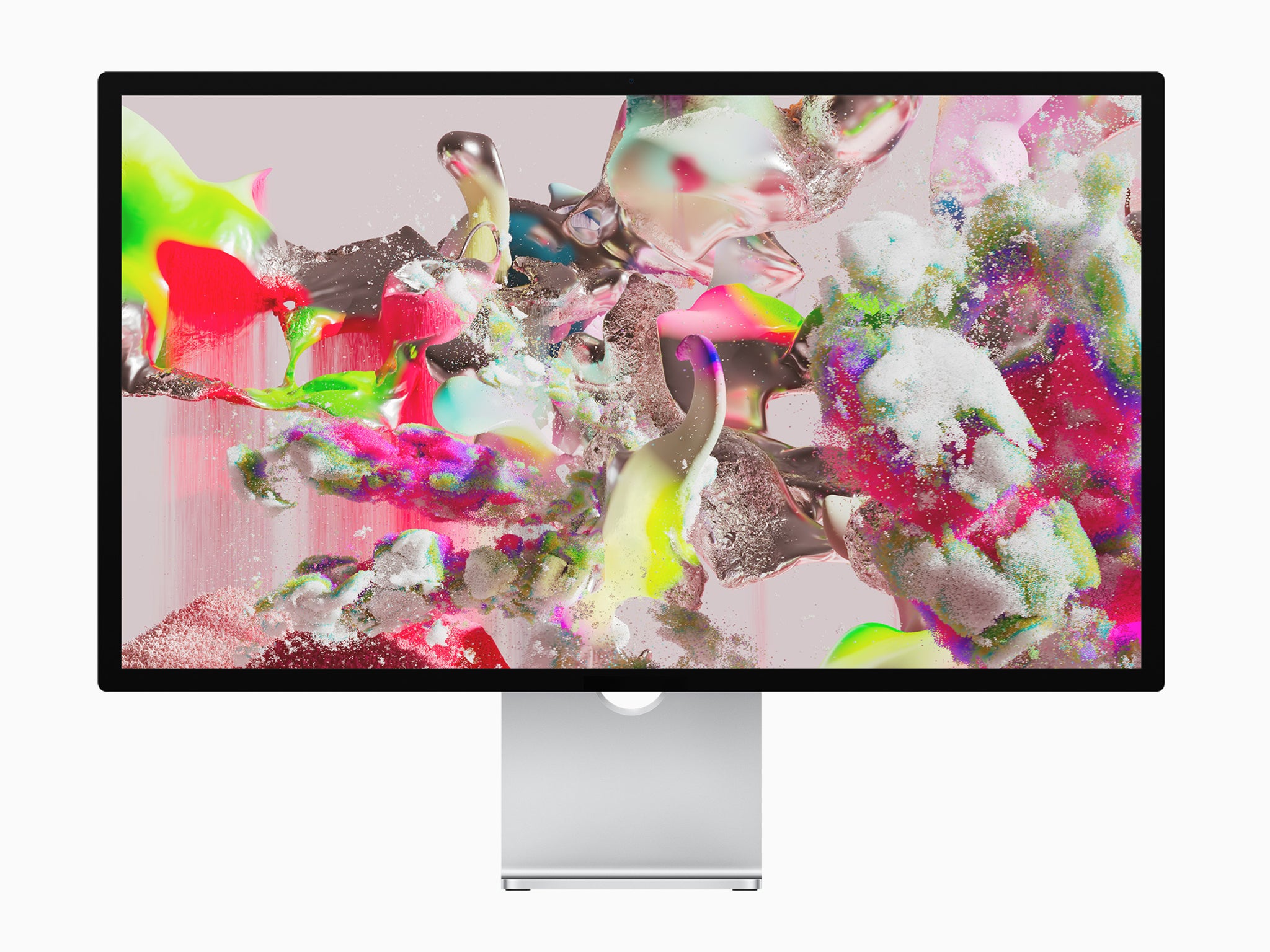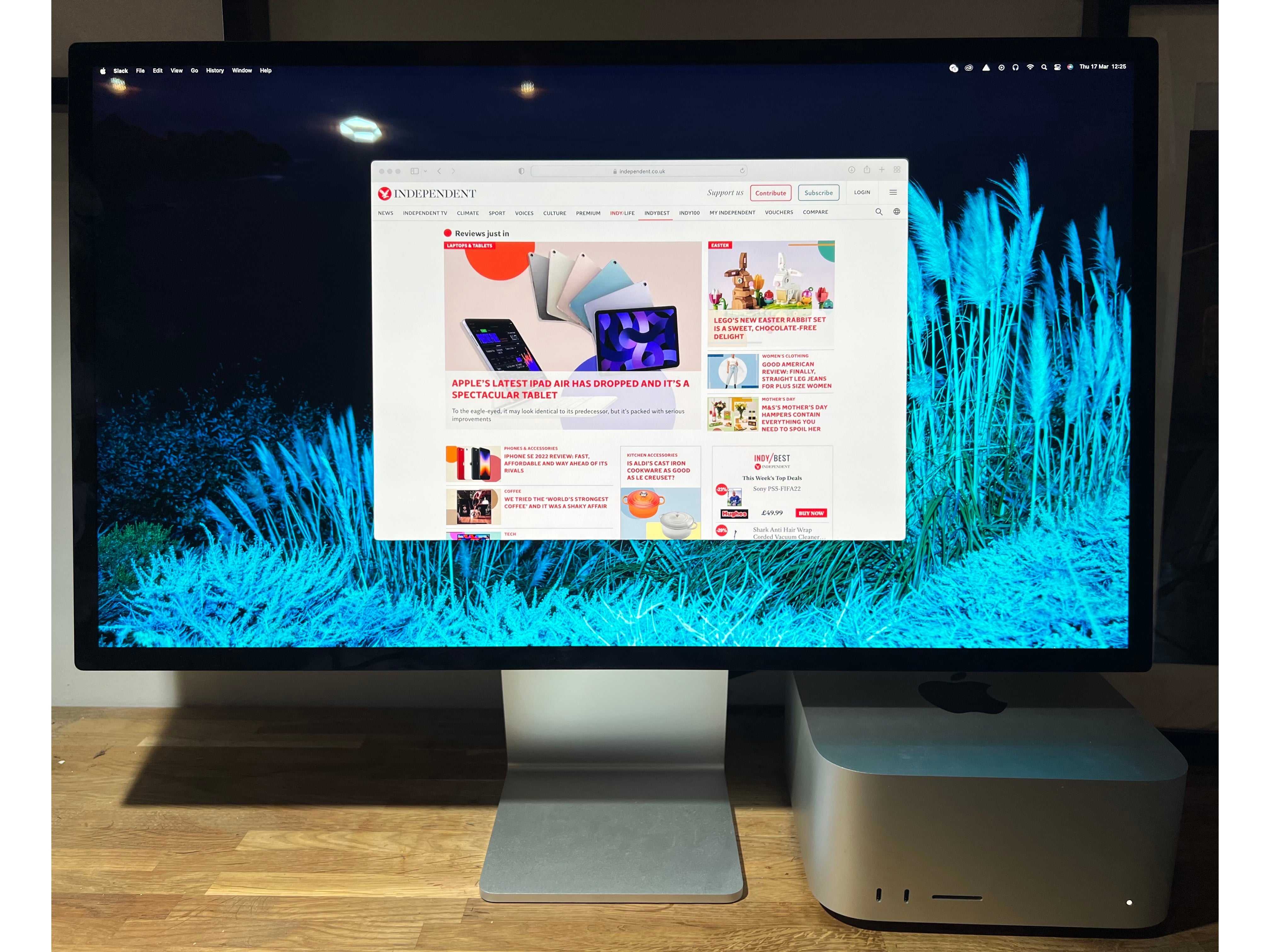The Independent's journalism is supported by our readers. When you purchase through links on our site, we may earn commission. Why trust us?
Apple studio display review: Six speakers and a sharp camera make this everything we’ve been waiting for
A delightful collision of beauty and practicality, it’s a screen that can handle anything you throw at it

Apple has not made a display for normal people for more than five years. It is a shocking fact – especially given how highly-regarded its screens are, and how central they are to the experience – and a state of affairs that has led to confusion and frustration for anyone who wanted a good experience out of the brand’s headless computers.
Now Apple has, finally, rectified that issue. The new studio display (£1,499, Apple.com) is a delightful return to form for the company, answering not only the question of where its screens had gone, but plenty more besides.
The studio display arrived alongside the Mac studio (£1,999, Apple.com), and the two sit very neatly next to each other. But the screen will also work well with any of Apple’s recent computers, from the cheaper headless Mac mini (£622.97, Amazon.co.uk) to as an extra display for a MacBook or even an iPad.
At £1,499, the new studio display is actually Apple’s cheaper model. It joins its sibling in the pro display XDR (£4,599, Apple.com) which is larger, more detailed and accurate, and includes professional features that mean Apple charges as much as £5,499 for one without a stand.
How we tested
We have been using the studio display for the past week, for both daily use as well as for specific tasks intended to test its performance. We looked not only for the picture quality but also ease of use, sound and the performance of the built-in camera. It has been plugged in not only to the new Mac studio, which is reviewed here, but to a range of other Apple products including an iPad to test compatibility.
Read more:
You can currently pre-order the Apple studio display (£1,499, Apple.com) until Friday 18 March, when it officially launches.
Apple studio display: £1,499, Apple.com

Rating: 9/10
- Size: 27in
- Resolution: 5,120 x 2,880, 218 ppi
- Brightness: 600 nits
- Camera: 12MP ultra-wide
- Audio: Six speakers with stereo sound; three microphones
- Connection: One Thunderbolt 3 (USB-C), three USB-C
- Dimensions: 47.8cm x 62.3cm x 16.8cm
- Weight: 6.3kg
Display design
Like the Mac studio (£1,999, Apple.com) it comes alongside, the studio display is not necessarily a beautiful thing. Switched off, and viewed from the front, it is a 27in black rectangle on an elegant aluminium stand; from the back, it is a silver rectangle with a black Apple logo.
In other words, it looks exactly like an Apple display, and isn’t trying to be anything else. In recent times, Apple has been criticised for a focus on beauty that has come at the expense of practicality; there is none of that here. It looks nice, but not excessively so.
Switch it on, and the display will light up with a rich 5K experience that is bright and vivid. The 14.7 million pixels inside glow with a billion colours that are ready for everything from the most intense work to watching films.
Read more: Apple MacBook pro – a radical update that’s miles ahead of the competition
The inclusion of Apple’s true tone technology is a quiet delight, too, meaning that the colours of the screen will adjust with the light, and white will always look truly white. Similarly, an anti-reflective coating means that you’ll never be able to see yourself in the screen, and you can pay more for a “nano-texture”, which keeps even bright light from showing up as glare.
Technically, the display is satisfactory and little more: it has support for a wide variety of reference modes, colour accuracy that will be decent enough for most design work, and with 600 nits of brightness it can glow enough for most uses though could sometimes do with a little more energy. There’s no support for fancier features, such as HDR, despite it being present in most other new and professional Apple displays.
The main reason the studio displays might not feel good enough is if you have ever had the opportunity to look at Apple’s pro display (£4,599, Apple.com). That is so bright, rich and precise that it has the effect of spoiling other screens. But it also costs about four times as much.
This is the striking, luminous Apple display for everyone else. As a screen, it does exactly what you expect of it – no more, no less – but people have been asking for exactly that for a very long time.
Connections
In the back of the studio display is a power cable that cannot be removed, plus three USB-C ports and one for Thunderbolt. The latter is where your computer plugs in, and the display can charge your MacBook when it is attached, making attaching and detaching from the display incredibly easy.
You can then plug whatever other things into those USB-C ports, from external drives to printers. They can stay plugged in, and any MacBook or other computer will be able to see them –once again, meaning that you can just detach your computer and go.

Again, the studio display and Mac studio arrived together, and work very neatly as a pair. But the screen is a great partner for any recent Mac, from any MacBook to the Mac studio’s headless siblings, the Mac pro (£5,499, Apple.com) and the Mac mini (£622.97, Amazon.co.uk).
The display also has a variety of options for stands. We tested the default option, the “tilt-adjustable stand”, which is nice enough, though perhaps puts the screen a little low; Apple is also selling one with height adjustment, or the option to use a VESA mount to attach it to another stand or to the wall.
They are all probably good, and all pricey. The main thing is to choose wisely, since the mount cannot be changed in the future.
Extras
Where the studio display really comes to life, however, is in its extras. By far the least interesting thing about this screen is the screen.
Those extras are about sound and vision. Apple has put an array of cameras, speakers, and microphones into the studio display to ensure that it can see and hear you as well as you can see and hear it.
Probably the most obvious improvement is a camera that is included at the top of the screen. For years, Apple’s cameras have been far worse than they should be, and that became very clear when lockdown arrived and people were Zooming on dark, fuzzy, grainy and unflattering cameras.
Read more: Apple iPhone 13 pro and iPhone pro max review
Recently, Apple has been looking to fix that in all of its new models, and it does so in style with the studio display’s camera. The camera itself is the same as the front-facing one in the iPad, and it is great to see Macs benefiting from the better resolutions of their tablet cousins.
It is also the first Mac camera to include Apple’s relatively new Centre Stage tool. It tracks your head as you move around, so that the camera can softly zoom in on where you really are.
It sounds like a novelty but it feels really good, ensuring that you stay in focus even if you move across the room. In a way, it is more useful even than it is on the iPad, since you can’t easily move the screen to follow yourself. (Just be prepared to look a little odd when you first join a Zoom meeting and the camera zooms towards your face, as if you are in a film.)
The quality from the camera, however, can be a bit smudgy and blurred, especially in low light. That would be more acceptable had Apple not added such stunningly crisp cameras to recent computers like the updated iMac. The picture is passable, but not brilliant.
Just as it can see you better than ever, if not more crisply, you can hear the Mac studio in stunning quality. With six speakers built in, Apple says this is the best audio system created for a Mac; that’s true, but a little modest, as it is one of the best sound systems ever to be built into something not meant primarily as an audio product, including much larger TVs. The computer also supports Apple’s spatial audio, which means that songs and films have a truly wide feel, with voices seeming to come from all around you.
Read more: The Apple iPhone SE is ahead of its rivals
Apple also says that the microphones are much improved, and they really are now suitable for anything apart from specific tasks like devoted music recordings. In video meetings or even when recording podcasts, you’ll sound crisp and sharp, and they are fantastic at cutting out other noise, such as your typing.
Those microphones also enable “Hey, Siri”, meaning that you can talk to the voice assistant whenever you want, which is an under-appreciated feature when you want to make a note on something you are reading, or send a message quickly before you forget.
All of these extra features are powered by Apple’s A13 Bionic chip, which sits at the heart of the display. That is the same processor that powered the iPhone 11 (£489, Currys.co.uk), and is still used in the iPad that Apple sells today.
When such features were rumoured, many wondered whether Apple would be using it in potentially exciting ways, such as allowing the display to work as an Apple TV (£169, Apple.com) when it was not plugged into a computer. There’s no sign that is the case, though of course Apple could turn it on after the fact.
The verdict: Apple studio display
It is, ultimately, unsurprising that Apple has made a stunning display: anyone who’s glanced at the lush colours and sharp resolution of a recent iPhone, iPad or Mac would expect that. Suffice to say the brand has lived up to those very high expectations. The only real surprise is that it took them so long to do so.
What is a nice surprise, however, is just how much extra there is happening. It would be easy to write off the improved camera and audio features as a pleasant addition – a little nice to have – were it not for the fact that they make the experience of using the display so much nicer. For many people now, a computer’s camera and audio system are among their primary ways of interacting with colleagues, friends and family, and so improvements to that are far from trivial.
The connections in the screen are similarly delightful. The studio display ably handles almost anything you throw at it, switching between connections as you need.
It all comes together to make a package that is, in the best possible way, everything we’d been waiting for from Apple. The studio display is a splendid collision of beauty and practicality, and you can’t take your eyes off it
